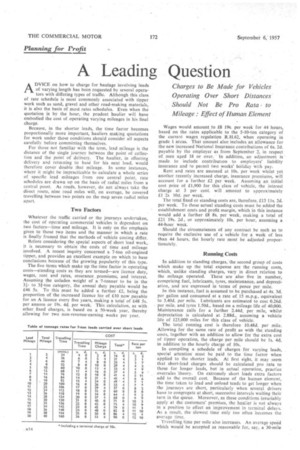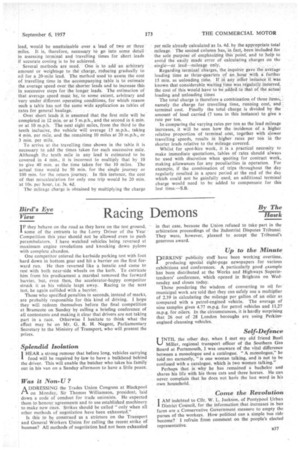A Leading Question
Page 88

Page 91

If you've noticed an error in this article please click here to report it so we can fix it.
ADVICE on how to charge for haulage involving leads of varying length has been requested by several operators with differing types of traffic. Although this class of rate schedule is most commonly associated with tipper work such as sand, gravel and other road-making materials, it is also the basis of most rates schedules. Even when the quotation is by the hour, the prudent haulier will have embodied the cost of operating varying mileages in his final charge.
Because, in the shorter leads, the time factor becomes proportionally more important, hauliers making quotations for work under those conditions should consider all aspects carefully before committing themselves.
For those not familiar with the term, lead mileage is the distance of the single journey between the point of collection and the point of delivery. The haulier, in effecting delivery and retuining to base for his next load, would therefore cover double that mileage. In some instances, where it might be impracticable to calculate a whole series of specific lead mileages from one central point, rate schedules are drawn up on the basis of radial miles from a central point. As roads, however, do not always take the direct route, nine road miles will, on average, be covered travelling between two points on the map seven radial miles apart.
Two Factors
Whatever the traffic carried or the journeys undertaken, the cost of operating commercial vehicles is dependent on two factors—time and mileage. It is only on the emphasis given to those two items and the manner in which a rate is finally framed that the methods of vehicle costing differ.
Before considering the special aspects of short lead work, it is necessary to obtain the costs of time and mileage involved, A recent inquiry concerned a 7-ton oil-engined tipper, and provides an excellent example on which to base conclusions because of the growing popularity of this type.
The five items which make up the time factor in operating costs—standing costs as they are termed—are licence duty, wages, rent and rates, insurance premiums, and interest. Assuming the unladen weight of a 7-tonner to be in the 31to 31-ton category, the annual duty payable would be £46 5s. To this must be added a further £2, being the proportion of the increased licence fee of £10 now payable for an A licence every five years, making a total of £48 5s. per annum or 19s. 4d. per week. This calculation, as with other fixed charges, is based on a 50-week year, thereby allowing for two non-revenue-earning weeks per year. Wages would amount to £8 19s. per week for 44 hours, based on the rates applicable to the 5-10-ton category of the current wages regulation R.H.62, when operating in grade 1 areas. That amount also includes an allowance for the new increased National Insurance contributions of 6s. 2d. payable by the employer as from September 2, in respect of men aged 18 or over. In addition, an adjustment is • made to include contribution to employers' liability insurance and to permit two week's' holiday with pay.
Rent and rates are assessed at 10s. per week whilst yet another recently increased charge, insurance premiums, will account for a further £2 per week. Assuming an initial cost price of £1,900 for this class of vehicle, the interest charge at 3 per cent. will amount to approximately £1 2s 10d. per week.
The total fixed or standing costs are, therefore, £13 Ils. 2d. per week. To these actual standing costs must be added the establishment costs and profit margin, which in this instance would add a further £8 8s. per week, making a total of £21 19s. 2d, or approximately 10s. per hour, assuming a 44-hour week.
Should the circumstances of any contract be such as to require the exclusive use of a vehicle for a week of less than 44 hours. the hourly rate must be adjusted proportionately.
Running Costs
In addition to standing charges, the second group of costs which make up the total expense are the running costs, which, unlike standing charges, vary in direct relation to the mileage operated. These are also five in number, comprising fuel, lubricants, tyres, maintenance, and depreciation, and are expressed in terms of pence per mile.
In this instance, fuel is assumed to be purchased at 4s. 3d. per gallon and consumed at a rate of. 15 m.p.g., equivalent to 3.40d. per mile. Lubricants are estimated to cost 0.26d. per mile, and tyres 1.50d., based on a mileage life of 40,000. Maintenance calls for a further 2.44d, per mile, whilst depreciation is calculated at 2.88d., assuming a vehicle life of 125,000 miles for this class of vehicle.
The total running cost is therefore 10.48d. per mile. Allowing for the same rate of profit as with the standing costs, together with an addition to allow for the extra cost of tipper operation, the charge per mile should be is. 4d, in addition to the hourly charge of 10s.
In compiling a schedule of charges for varying leads, special attention must be paid to the time factor when applied to the shorter leads. At first sight, it may seem that short-lead charges should be calculated pro rata to those for longer leads, but in actual operation, practice overrules 'theory. On extremely short leads extra factors add to the overall cost. Because of the human element, the time taken to load and unload tends to get longer when the journeys are short, particularly when several drivers have to congregate at short, successive intervals waiting their turn in the queue. Moreover, as these conditions invariably apply at the customers' premises, the haulier is not always in a position to effect an improvement in terminal delays. As a result, the slowest time only too often becomes the average time.
Travelling time per mile also increases. An average speed which would be accepted as reasonable for, say, a 30-mile lead, would be unattainable over a lead of two or three miles. It is, therefore, necessary to go into some detail in assessing terminal and travelling times for short leads if accurate costing is to be achieved.
Several methods are used. One is to add an arbitrary amount or weightage to the charge, reducing gradually to nil for a 20-mile lead. The method used to assess the cost of travelling time in the accompanying table is to estimate the average speed over the shorter leads and to increase this in successive steps for the longer leads. The estimation of that average speed must be, to some extent, arbitrary and vary under different operating conditions, for which reason such a table has not the same wide application as tables of rates for general haulage.
Over short leads it is assumed that the first mile will be completed in 12 mm. or at 5 m.p.h., and the second in 6 min, or at 10 m.p.h. The next eight miles, from the third to the tenth inclusive, the vehicle will average 15 m.p.h., taking 4 min. per mile, and the remaining 10 miles at 20 m.p.h., or 3 min. per mile.
To arrive atthe travelling time shown in the table it is necessary to add the times taken for each successive mile. Although the tenth mile in any lead is estimated to be covered in 4 min., it is incorrect to multiply that by 10 to give 40 min. as the time taken for the 10 miles. The actual time would be 50 min. for the single journey or 100 min. for the return journey. In this instance, the cost of that miscalculation for only one trip would be 20 min. at 10s per hour, i.e. 3s. 4d.
The mileage charge is obtained by multiplying the charge
per mile already calculated as Is. 4d. by the appropriate total mileage. The second column has in facts been included for the sole purpose of emphasizing this point, and to -help to avoid the easily made error of calculating charges on the single—or lead—mileage only.
Regarding terminar.charges, the inquirer gave the average loading time as three-quarters of an ..hour with 4 further 15 min. as unloading tithe. If in any 'other InStarice it was known that considerable waiting time Was regularly incurred. the cost of this would .have to be added.to that of the actual loading and unloading times
The total charge is therefore a combination of three items, namely the charge for travelling time, running cost, and. terminal cost. Finally the total charge is divided by the amount of load carried (7 tons in this instance) to give a rate per ton.
In comparing the varying rates per ton as the lead mileage increases, it will be seen how the incidence of a higher relative proportion of terminal cost, together with slower travelling 'speeds, results in higher rates per ton in the shorter leads relative to the mileage covered.
Whilst for spot-hire work, it is a practical necessity to make immediate quotations, tables of rates should always be used with discretion when quoting for contract work, making allowances for any peculiarities in operation. For example, if the combination of trips throughout the day regularly resulted in a spare period at the end of the day which could not be gainfully used, an additional terminal charge would need to be added to compensate for this lost time.—S.B.




























































































































